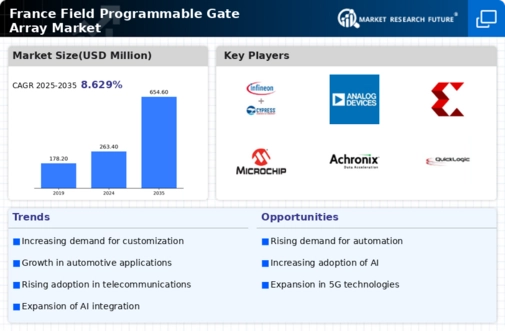The field programmable-gate-array market in France is characterized by a dynamic competitive landscape, driven by rapid technological advancements and increasing demand for customizable solutions across various sectors. Key players such as Xilinx (US), Intel (US), and Lattice Semiconductor (US) are at the forefront, each adopting distinct strategies to enhance their market presence. Xilinx (US) focuses on innovation through its Versal ACAP platform, which integrates AI capabilities, while Intel (US) emphasizes its strong R&D investments to bolster its FPGA offerings. Lattice Semiconductor (US) is strategically positioning itself in the low-power segment, catering to the growing need for energy-efficient solutions, particularly in IoT applications. Collectively, these strategies contribute to a competitive environment that is increasingly centered around technological differentiation and customer-centric solutions.
In terms of business tactics, companies are localizing manufacturing and optimizing supply chains to enhance responsiveness to market demands. The market structure appears moderately fragmented, with several players vying for market share, yet dominated by a few key firms that wield considerable influence. This competitive structure fosters innovation, as companies strive to differentiate their products and services in a crowded marketplace.
In October 2025, Xilinx (US) announced a strategic partnership with a leading AI research institute to develop next-generation FPGA solutions tailored for machine learning applications. This collaboration is poised to enhance Xilinx's capabilities in AI integration, potentially positioning the company as a leader in this burgeoning segment. The partnership underscores the importance of aligning technological advancements with market needs, thereby reinforcing Xilinx's competitive edge.
In September 2025, Intel (US) unveiled its latest FPGA architecture, which incorporates advanced security features aimed at addressing the growing concerns around data protection in cloud environments. This move is significant as it not only enhances Intel's product portfolio but also responds to the increasing demand for secure computing solutions. By prioritizing security, Intel is likely to attract a broader customer base, particularly in sectors where data integrity is paramount.
In August 2025, Lattice Semiconductor (US) expanded its product line with the introduction of a new low-power FPGA designed specifically for automotive applications. This strategic launch reflects Lattice's commitment to tapping into the automotive sector, which is experiencing a surge in demand for advanced electronic systems. By focusing on this niche, Lattice is positioning itself to capture market share in a rapidly evolving industry.
As of November 2025, the competitive trends in the field programmable-gate-array market are increasingly defined by digitalization, sustainability, and the integration of AI technologies. Strategic alliances are becoming more prevalent, as companies recognize the value of collaboration in driving innovation and enhancing product offerings. Looking ahead, competitive differentiation is likely to evolve from traditional price-based competition to a focus on innovation, technological advancements, and supply chain reliability. This shift suggests that companies that prioritize R&D and strategic partnerships will be better positioned to thrive in the future.






















Leave a Comment